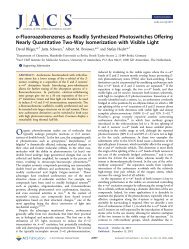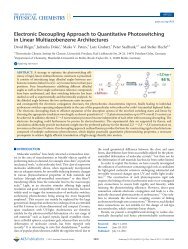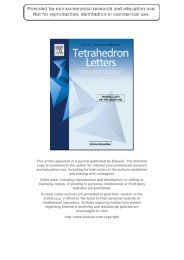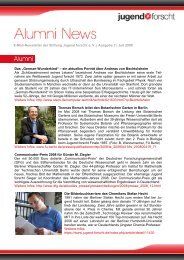Synthesis and Characterization of Azobenzene ... - HechtLab
Synthesis and Characterization of Azobenzene ... - HechtLab
Synthesis and Characterization of Azobenzene ... - HechtLab
Create successful ePaper yourself
Turn your PDF publications into a flip-book with our unique Google optimized e-Paper software.
<strong>Synthesis</strong> <strong>and</strong> <strong>Characterization</strong> <strong>of</strong><br />
<strong>Azobenzene</strong>-Confined Porphyrins<br />
Maike V. Peters, Richard Goddard, <strong>and</strong> Stefan Hecht*<br />
Max-Planck-Institut für Kohlenforschung, Kaiser-Wilhelm-Platz<br />
1, 45470 Mülheim an der Ruhr, Germany<br />
hecht@mpi-muelheim.mpg.de<br />
ReceiVed June 22, 2006<br />
A versatile synthetic method has been developed to incorporate<br />
photochromic azobenzene moieties into tetraphenylporphyrin<br />
frameworks in an orthogonal fashion, positioning<br />
the phenylazo substituents above <strong>and</strong> below the plane <strong>of</strong> the<br />
macrocycle. Surprisingly, photoisomerization is completely<br />
suppressed in the resulting azobenzene-confined porphyrins.<br />
The creation <strong>of</strong> stimulus-responsive molecules <strong>and</strong> materials<br />
capable <strong>of</strong> undergoing reversible property changes is <strong>of</strong> great<br />
interest for future technology. Light represents perhaps the most<br />
attractive external stimulus because it can be applied in a<br />
noninvasive fashion, i.e., without production <strong>of</strong> byproducts, <strong>and</strong><br />
with exquisite control over time <strong>and</strong> location <strong>of</strong> exposure. In<br />
this context, photochromic molecules are <strong>of</strong> great interest since<br />
geometrical <strong>and</strong> electronic changes upon switching can be used<br />
to affect structure <strong>and</strong> function at the molecular level. 1 Arguably,<br />
catalysis is among the most attractive functions to photoswitch.<br />
However, reversible photomodulation <strong>of</strong> catalytic activity has<br />
thus far been poorly explored, <strong>and</strong> the few reported cases 2 suffer<br />
from a lack <strong>of</strong> generality <strong>and</strong> low on/<strong>of</strong>f-ratios, i.e., small<br />
changes in activity. In search <strong>of</strong> a more general photoswitchable<br />
(1) (a) Photochromism - Molecules <strong>and</strong> Systems; Dürr, H., Bouas-<br />
Laurent H., Eds.; Elsevier: Amsterdam, 2003. (b) Molecular Switches;<br />
Feringa, B. L., Ed.; Wiley-VCH: Weinheim, 2001. (c) Organic Photochromic<br />
<strong>and</strong> Thermochromic Compounds; Crano, J. C., Guglielmetti, R.<br />
J., Eds.; Kluwer Academic/Plenum Publishers: New York, 1999. (d)<br />
Organic Photochromes; El’tsov, A. V., Ed.; Consultants Bureau: New York,<br />
1990. (e) Special Issue: Photochromism: Memories <strong>and</strong> Switches. Irie,<br />
M., Ed. Chem. ReV. 2000, 100, 1683-1890. (f) Hecht, S. Small 2005, 1,<br />
26-29.<br />
(2) (a) Ueno, A.; Takahashi, K.; Osa, T. J. Chem. Soc., Chem. Commun.<br />
1981, 94-96. (b) Würthner, F.; Rebek, J., Jr. Angew. Chem., Int. Ed. Engl.<br />
1995, 34, 446-448. (c) Würthner, F.; Rebek, J., Jr. J. Chem. Soc. Perkin<br />
Trans. 2 1995, 1727-1734. (d) Cacciapaglia, R.; Di Stefano, S.; M<strong>and</strong>olini,<br />
L. J. Am. Chem. Soc. 2003, 125, 2224-2227. (e) Sud, D.; Norsten, T. B.;<br />
Br<strong>and</strong>a, N. R. Angew. Chem., Int. Ed. 2005, 44, 2019-2021.<br />
FIGURE 1. Concept <strong>of</strong> photomodulating axial accessibility <strong>and</strong><br />
therefore catalytic activity in azobenzene-substituted metalloporphyrins.<br />
catalyst, we targeted photocontrol over the accessibility to<br />
metalloporphyrins, 3 which are ubiquitous in Nature 4 since they<br />
perform important binding, activation, <strong>and</strong> catalytic processes.<br />
Our design involves the direct incorporation <strong>of</strong> an azobenzene<br />
unit into the framework <strong>of</strong> a meso-tetraphenylporphyrin in such<br />
a way that two o-phenylazo substituents can occupy the space<br />
above <strong>and</strong> below the plane <strong>of</strong> the metalloporphyrin leading to<br />
an effective shielding <strong>of</strong> the catalytically active metal center<br />
(Figure 1). We expected that, upon irradiation, the large<br />
structural reorganization accompanying the E-Z-isomerization<br />
<strong>of</strong> the azobenzenes would open the pocket <strong>and</strong> dramatically<br />
increase access to the axial positions <strong>of</strong> the metal center, thereby<br />
enabling binding <strong>and</strong> catalysis to occur. 5 Here, we report the<br />
efficient synthesis as well as structural <strong>and</strong> photophysical<br />
characterization <strong>of</strong> a novel bisazobenzene-substituted porphyrin<br />
derivative.<br />
Some examples <strong>of</strong> azobenzene-containing (metallo)porphyrins<br />
have been reported. However, they mostly carry the azobenzene<br />
unit either in the para position <strong>of</strong> the meso-phenyl group, 6 via<br />
a flexible linker, 7 or by axial coordination. 8 In the reported cases,<br />
either no or contradictory findings with regard to the photoisomerization<br />
have been given. To test our design concept, we<br />
targeted porphyrin 3 (Scheme 1), in which only two azobenzene<br />
units were introduced into the porphyrin skeleton via one meso-<br />
[2,6-bis(phenylazo)phenyl] group to limit the number <strong>of</strong> possible<br />
switching states, i.e., E,E vs E,Z vs Z,Z. The meta relationship<br />
prohibits electronic communication between the phenylazo<br />
substituents <strong>and</strong> ensures independent isomerization events. 9 The<br />
(3) The Porphyrin H<strong>and</strong>book; Kadish, K., Smith, K. M., Guilard, R.,<br />
Eds.; Academic Press: New York, 1999.<br />
(4) Milgrom, L. R. The Colors <strong>of</strong> Life; Oxford University Press: New<br />
York, 1997.<br />
(5) An alternative supramolecular approach based on E-Z-photoisomerization<br />
<strong>of</strong> a stilbene-type pyridine lig<strong>and</strong> leads to photomodulation <strong>of</strong> axial<br />
ligation in aluminum porphyrins <strong>and</strong> hence catalytic activity in the<br />
copolymerization <strong>of</strong> carbon dioxide <strong>and</strong> ethylene oxide: Sugimoto, H.;<br />
Kimura, T.; Inoue, S. J. Am. Chem. Soc. 1999, 121, 2325-2326.<br />
(6) (a) Hombrecher, H. K.; Lüdtke, K. Tetrahedron 1993, 49, 9489-<br />
9494. (b) Autret, M.; Le Plouzennec M.; Moinet, C.; Simonneaux, G. J.<br />
Chem. Soc., Chem. Commun. 1994, 1169-1170. (c) Hunter, C. A.; Sarson,<br />
L. D. Tetrahedron Lett. 1996, 37, 699-702. (d) Tsuchiya, S. J. Am. Chem.<br />
Soc. 1999, 121, 48.<br />
(7) (a) Neumann, K. H.; Vögtle, F. J. Chem. Soc., Chem. Commun. 1988,<br />
520-522. (b) Yamara, T.; Momotake, A.; Arai, T. Tetrahedron Lett. 2004,<br />
45, 9219-9223.<br />
(8) Otsuki, J.; Harada, K.; Araki, K. Chem. Lett. 1999, 28, 269-270.<br />
(b) Reddy, D. R.; Maiya, B. G. Chem. Commun. 2001, 117-118. (c) Reddy,<br />
D. R.; Maiya, B. G. J. Phys. Chem. A 2003, 107, 6326-6333.<br />
7846 J. Org. Chem. 2006, 71, 7846-7849<br />
10.1021/jo0612877 CCC: $33.50<br />
© 2006 American Chemical Society<br />
Published on Web 08/29/2006
SCHEME 1.<br />
<strong>Synthesis</strong> <strong>of</strong> Target Azoporphyrin<br />
FIGURE 2. Structure <strong>of</strong> 3(CH 3CN) crystallized from CH 3CN, showing<br />
the near-orthogonal arrangement <strong>of</strong> the meso-aryl substituents to the<br />
porphyrin ring. (Solute CH 3CN <strong>and</strong> disorder <strong>of</strong> one methoxy group<br />
are omitted for clarity. Zn: orange; C: green; N: blue; O: red.)<br />
(9) Ito, Y.; Ito, H.; Matsuura, Y. Tetrahedron Lett. 1988, 29, 563-566.<br />
(10) Peters, M. V.; Stoll, R. S.; Goddard, R.; Buth, G.; Hecht, S. J. Org.<br />
Chem. 2006, 71, 7840-7845.<br />
(11) Lee, C.-H.; Lindsey, J. S. Tetrahedron 1994, 50, 11427-11440.<br />
(12) Milaneso, M. E.; Morán, F. S.; Yslas, E. I.; Alvarez, M. G.; Rivarola,<br />
V.; Durantini, E. Bioorg. Med. Chem. 2001, 9, 1943-1949.<br />
(13) This useful protocol for azobenzene formation has been developed:<br />
Lim, Y.-K.; Lee, K.-S.; Cho, C.-G. Org. Lett. 2003, 5, 979-982.<br />
FIGURE 3. Absorbance (solid), excitation (λ em ) 590 nm, dotted),<br />
<strong>and</strong> emission (λ exc ) 424 nm, dashed) spectra <strong>of</strong> 2 (blue) <strong>and</strong> 3 (red)<br />
in CH 3CN.<br />
remaining three meso positions were occupied by spectator<br />
groups, i.e., 2,4,6-trimethoxyphenyl groups. The use <strong>of</strong> orthodisubstituted<br />
meso-substituents is key to the design in order to<br />
ensure their orthogonal orientation with respect to the plane <strong>of</strong><br />
the metalloporphyrin. It should be noted that accessibility could<br />
in principle be readily tuned by adjusting the size <strong>of</strong> the spectator<br />
substituents (Ar in Scheme 1) <strong>and</strong> by enlarging the phenylazo<br />
groups via substitution in the 4- or 3,5-positions.<br />
Initial attempts to synthesize target porphyrin 3 from the<br />
corresponding 2,6-bis(phenylazo)benzaldehyde failed due to the<br />
illusive nature <strong>of</strong> o-formylazobenzenes. 10 Instead, porphyrin 3<br />
could be accessed by starting from the nonsymmetric zinc<br />
5-(2,6-dibromophenyl)-10,15,20-tris(2,4,6-trimethoxyphenyl)-<br />
porphyrin 1, which was readily prepared via a mixed condensation<br />
11 <strong>of</strong> 2,6-dibromobenzaldehyde <strong>and</strong> 2,4,6-trimethoxybenzaldehyde<br />
with its corresponding dipyrromethane 12 followed by<br />
oxidation <strong>of</strong> the formed porphyrinogen <strong>and</strong> zinc insertion. The<br />
sterically hindered aryl bromide functionalities in 1 were<br />
converted to the corresponding tert-butyloxycarbonyl-protected<br />
phenylhydrazides via a Pd-catalyzed cross-coupling reaction to<br />
yield 2, which after subsequent deprotection/oxidation afforded<br />
the desired zinc porphyrin 3 in good yield (Scheme 1). 13<br />
Importantly, this porphyrin postfunctionalization procedure<br />
allows in principle for the preparation <strong>of</strong> a large array <strong>of</strong><br />
azobenzene-substituted porphyrin structures.<br />
The structure <strong>of</strong> target 3 was unambiguously characterized<br />
by single-crystal X-ray analysis <strong>of</strong> its CH 3 CN complex (Figure<br />
2). Crystals were grown from acetonitrile <strong>and</strong> from acetonitrile/<br />
cyclohexane (reservoir) by the hanging drop method. The<br />
acetonitrile molecule is terminally bound to the zinc center,<br />
giving rise to a square pyramidal complex in which the zinc<br />
atom has moved out <strong>of</strong> the plane <strong>of</strong> the porphyrin ring by ca.<br />
0.28(7) Å. The meso-[2,6-bis(phenylazo)phenyl] as well as all<br />
three meso-2,4,6-trimethoxyphenyl groups are oriented approximately<br />
orthogonal to the plane <strong>of</strong> the porphyrin ring,<br />
presumably due to the presence <strong>of</strong> the ortho substituents, with<br />
plane angles in the range 75-90°. The absence <strong>of</strong> close contacts<br />
between the aryl substituents in the crystal suggests that the<br />
structure is representative <strong>of</strong> the system in solution. Indeed,<br />
inspection <strong>of</strong> the 1 H NMR spectrum in CD 3 CN (see the<br />
Supporting Information) corroborates the crystal structure, most<br />
notably by revealing the loss <strong>of</strong> the planar symmetry due to<br />
acetonitrile ligation <strong>and</strong> exhibiting an unusual upfield shift (∆δ<br />
∼1 ppm with regard to non-porphyrin model compounds) <strong>of</strong><br />
the terminal phenyl protons <strong>of</strong> the azobenzenes due to their<br />
specific location with regard to the ring current <strong>of</strong> the porphyrin<br />
macrocycle.<br />
Inspection <strong>of</strong> the absorption spectrum <strong>of</strong> 3 (Figure 3)<br />
corroborates the presence <strong>of</strong> porphyrin <strong>and</strong> azobenzene chromophores.<br />
Comparison with 2, displaying the negligible intrinsic<br />
porphyrin absorption in the UV, validates the possibility <strong>of</strong><br />
selective excitation <strong>of</strong> the azobenzene moieties around 300-<br />
350 nm. However, irradiation <strong>of</strong> solutions <strong>of</strong> 3 under various<br />
conditions, i.e., various solvents (CH 3 CN, CH 2 Cl 2 , THF 14 ),<br />
excitation wavelengths (313 <strong>and</strong> 365 nm), <strong>and</strong> concentrations<br />
(10 -5 - 10 -7 M), led to no observable change in the UV/vis<br />
spectra. Clearly, photoisomerization <strong>of</strong> the azobenzene moiety<br />
does not occur in this system. Exchanging the central metal<br />
atom did not alter the photochemistry.<br />
To underst<strong>and</strong> this unexpected behavior <strong>and</strong> to qualitatively<br />
elucidate excitation energy migration in this multichromophore<br />
(14) Only in THF photochemistry was observed, giving rise to irreversible<br />
production <strong>of</strong> as yet unidentified photoproducts.<br />
J. Org. Chem, Vol. 71, No. 20, 2006 7847
system, fluorescence emission <strong>and</strong> excitation spectra <strong>of</strong> 3 <strong>and</strong><br />
the corresponding azobenzene-free model compound 2 were<br />
recorded (Figure 3). The excitation spectrum <strong>of</strong> 3 reveals<br />
significant participation <strong>of</strong> the azobenzene moieties in populating<br />
the emitting state <strong>and</strong> thereby points to efficient fluorescence<br />
resonance energy transfer (FRET) from the azobenzene moieties<br />
to the zinc porphyrin chromophore. 15 Interestingly, while 2<br />
displays a fluorescence spectrum <strong>and</strong> quantum yield (Φ f ) 2<br />
× 10 -3 ) typical for zinc porphyrins, 3 3 shows a qualitatively<br />
similar emission spectrum yet with a greatly diminished intensity<br />
(Φ f ) 6 × 10 -6 ). Obviously, the presence <strong>of</strong> the azobenzene<br />
moieties leads to efficient fluorescence quenching, most likely<br />
due to photoinduced electron transfer (PET). Furthermore, it<br />
should be noted that 3 displays a rather broad Soret b<strong>and</strong> (fwhm<br />
) 23 nm) as compared to 2 (fwhm ) 13 nm), which indicates<br />
some sort <strong>of</strong> yet unexplained electronic interaction in the ground<br />
state.<br />
These observations suggest that the dominant pathway for<br />
excitation energy migration in 3 is: initial FRET from the<br />
azobenzene donor to the zinc porphyrin acceptor, subsequent<br />
PET from the zinc porphyrin core to the azobenzene moiety,<br />
followed by final charge recombination to relax to the ground<br />
state. The efficient FRET process, preventing photoisomerization<br />
in the system, is strongly facilitated by the close distance <strong>and</strong><br />
the significant spectral overlap 16 <strong>of</strong> the azobenzene donor <strong>and</strong><br />
zinc porphyrin acceptor <strong>and</strong> most likely dominated by the<br />
Förster mechanism. 17 PET has been observed in a related<br />
system. 6b Comparing our results with various other reports on<br />
azobenzene-appended porphyrins, 6-8 we believe that successful<br />
photoisomerization can only be achieved by moving the<br />
azobenzene photochrome further away 7 from the porphyrin<br />
moiety or by electronically decoupling both chromophores. 8 This<br />
finding is particularly important for the design <strong>of</strong> photoswitchable<br />
porphyrin-based catalysts such as proposed here as<br />
well as other molecular devices in which mechanical motion is<br />
powered by azobenzene photoisomerization. 18<br />
Experimental Section<br />
<strong>Synthesis</strong> <strong>of</strong> Azoporphyrin 3. 5-(2,6-Dibromophenyl)-10,15,<br />
20-(2,4,6-trimethoxyphenyl)porphyrin 1 FB . Under an argon atmosphere,<br />
a flask was charged with 577 mg (2.94 mmol) <strong>of</strong> 2,4,6-<br />
trimethoxybenzaldehyde, 776 mg (2.94 mmol) <strong>of</strong> 2,6-dibromobenzaldehyde,<br />
<strong>and</strong> 1.84 g (5.88 mmol) <strong>of</strong> 2,4,6-trimethoxyphenyldipyrromethane<br />
12 dissolved in 577 mL <strong>of</strong> chlor<strong>of</strong>orm, <strong>and</strong> argon<br />
was passed through the solution for 10 min. Subsequently, 0.25<br />
mL (1.94 mmol) <strong>of</strong> BF 3 ‚OEt 2 was added, <strong>and</strong> the solution was<br />
stirred at room temperature for 1 h. Then, 2 g (8.82 mmol) <strong>of</strong> DDQ<br />
was added, <strong>and</strong> the reaction mixture was stirred overnight. The<br />
solvent was removed under reduced pressure. Purification by<br />
column chromatography (CH 2 Cl 2 f 2vol%EAinCH 2 Cl 2 ) gave<br />
141 mg <strong>of</strong> the product as a dark purple solid (5%): R f (CH 2 Cl 2 /<br />
EA, 50/1) ) 0.46; 1 H NMR (CDCl 3 , 400 MHz, 27 °C) δ (ppm) )<br />
(15) Due to experimental reasons, i.e., spectral overlap with the overtone<br />
b<strong>and</strong>, low emission intensity, <strong>and</strong> residual porphyrin UV-absorption, the<br />
FRET efficiency could not be determined quantitatively.<br />
(16) Although azobenzene is not fluorescent at room temperature, its<br />
emission spectrum has been determined; see: Fujino, T.; Arzhansev, S.<br />
Y.; Tahara, T. J. Phys. Chem. A 2001, 105, 8123-8129. The emission<br />
maximum is located around 390 nm, thereby exhibiting significant spectral<br />
overlap with the intense zinc porphyrin Soret b<strong>and</strong>.<br />
(17) Scholes, G. D. Annu. ReV. Phys. Chem. 2003, 54, 57.<br />
(18) Muraoka, T.; Kinbara, K.; Aida, T. Nature (London) 2006, 440,<br />
512-515.<br />
8.74 (d, 2 H, 3 J ) 4.5 Hz), 8.71 (s, 4 H, pyrrole-H), 8.50 (d, 2 H,<br />
3<br />
J ) 4.5 Hz, pyrrole-H), 7.96 (d, 2 H, 3 J ) 8.1 Hz, Ph-m-H), 7.45<br />
(t,1H, 3 J ) 8.1 Hz, Ph-p-H), 6.54 (s, 6 H, Ph-3,5-H), 4.07 (s, 9<br />
H, Ph-OCH 3 ), 3.46 (s, 18H, Ph-OCH 3 ), -2.53 (s, 2H, N-H); MS<br />
(ESI) m/z ) 1040 ([M + H] + ); HRMS (ESI) m/z ) 1041.169917<br />
(calcd 1041.170459 for C 53 H 47 N 4 O 9 Br 2 ).<br />
Zinc 5-(2,6-Dibromophenyl)-10,15,20-(2,4,6-trimethoxyphenyl)porphyrin<br />
1. A flask was charged with 152 mg (0.150 mmol)<br />
<strong>of</strong> 1 FB dissolved in 80 mL <strong>of</strong> chlor<strong>of</strong>orm/methanol (1:1). Then, 167<br />
mg (0.75 mmol) <strong>of</strong> zinc acetate dihydrate was added <strong>and</strong> the<br />
solution was stirred at 50 °C overnight, during which time a color<br />
change from wine red to pink was observed. The solvent was<br />
evaporated. The solution was washed with aq NaHCO 3 <strong>and</strong> water<br />
<strong>and</strong> dried over MgSO 4 , <strong>and</strong> the solvent was removed in vacuo to<br />
yield 159 mg <strong>of</strong> a dark pink solid (95%): 1<br />
H NMR (CDCl 3 , 400<br />
MHz, 27 °C) δ (ppm) ) 8.78 (broad s, 6 H, pyrrole-H), 8.57 (broad<br />
s, 2 H, pyrrole-H), 7.98 (broad s, 2 H, 3,5-Ph-H), 7.43 (t, 1 H, 3 J<br />
) 8 Hz, 4-Ph-H), 6.56 (broad s, 6 H, 3,5-Ph-H), 4.08 (s, 9 H, 4-Ph-<br />
OCH 3 ), 3.50 (broad s, 18 H, 2,6-Ph-OCH 3 ); MS (ESI) m/z ) 1103<br />
([M + H] + ), 1125 ([M + Na] + ), 1145 ([M + K] + ); HRMS (ESI)<br />
m/z ) 1103.08360 (calcd 1103.083951 for C 53 H 45 N 4 O 9 ZnBr 2 ).<br />
Zinc 5-(2,6-Bis(N-tert-butoxycarbonyl-N′-phenylhydrazino)-<br />
phenyl)-10,15,20-(2,4,6-trimethoxyphenyl)porphyrin 2. Under an<br />
argon atmosphere, a sealed tube was charged with 105 mg (0.095<br />
mmol) <strong>of</strong> 1, 75 mg (0.38 mmol) <strong>of</strong> 1-tert-butoxycarbonyl-1-<br />
phenylhydrazine, 19 23 mg (0.114 mmol) <strong>of</strong> Pd(OAc) 2 , 186 mg (0.57<br />
mmol) <strong>of</strong> Cs 2 CO 3 , 0.23 mL (0.114 mmol) <strong>of</strong> tri-tert-butylphosphine<br />
solution (1 g in 10 mL toluene), <strong>and</strong> 4.5 mL <strong>of</strong> toluene. The mixture<br />
was stirred at room temperature for 30 min <strong>and</strong> was then heated to<br />
110 °C for 5 h. After short filtration over Celite, using CH 2 Cl 2 as<br />
the eluent, column chromatography (hexane/THF, 2/1) afforded 60<br />
mg <strong>of</strong> the product as a purple solid (50%): R f (THF/Hex, 2/1) )<br />
0.56; 1 H NMR (CDCl 3 , 300 MHz, 27 °C) δ (ppm) ) 8.94 (s, 2 H,<br />
pyrrole-H), 8.82 (s, 6 H, pyrrole-H), 7.45 (t, 1 H, 3 J ) 8.2 Hz,<br />
p-Ph-H), 7.23 (d, 4 H, Ph-H), 7.03 (t, 4 H, 3 J ) 8.2 Hz, Ph-H),<br />
6.85 (t, 2 H, 3 J ) 7.2 Hz, Ph-H), 6.71 (d, 2 H, 3 J ) 8.2 Hz, m-Ph-<br />
H), 6.55 (s, 2 H, Ph-H), 6.58 (s, 4 H, Ph-H), 4.11 (s, 6 H, Ph-<br />
OCH 3 ), 4.08 (s, 3 H, Ph-OCH 3 ), 3.49 (s, 12 H, Ph-OCH 3 ), 3.47 (s,<br />
6 H, Ph-OCH 3 ), 1.29 (s, 18 H, Boc-H); MS (ESI) m/z ) 1358 (M + ),<br />
1381 ([M + Na] + ); HRMS (ESI) m/z ) 1387.455675 (calcd<br />
1381.455896 for C 75 H 74 N 8 O 13 NaZn).<br />
Zinc 5-(2,6-Bis(phenylazo)phenyl)-10,15,20-(2,4,6-trimethoxyphenyl)porphyrin<br />
3. Under an argon atmosphere, a flame-dried<br />
Schlenk tube was charged with 21 mg (0.016 mmol) <strong>of</strong> 2, 27mg<br />
(0.13 mmol) <strong>of</strong> CuI, 44 mg (0.13 mmol) <strong>of</strong> Cs 2 CO 3 , <strong>and</strong> 0.25 mL<br />
<strong>of</strong> dry DMF. The reaction mixture was heated at 140 °C for 4.5 h.<br />
Column chromatography (CH 2 Cl 2 /EA, 50/1) provided 9 mg <strong>of</strong> the<br />
product as a purple solid (49%): R f (CH 2 Cl 2 /EA, 20/1) ) 0.54; 1 H<br />
NMR (CD 3 CN, 400 MHz, 27 °C) δ (ppm) ) 8.64 (m, 4 H, Py-H)<br />
8.58 (m, 4 H, Py-H), 8.20 (d, 2 H, 3 J ) 8 Hz, Ph-H), 8.07 (t, 1 H,<br />
3<br />
J ) 7.4 Hz, Ph-H), 6.91 (t, 2 H, 3 J ) 7.3 Hz, Ph-H), 6.68 (m, 6<br />
H, Ph-H), 6.59 (m, 8 H, Ph-H), 4.06 (s, 3 H, p-OCH 3 ), 4.01 (s, 6<br />
H, o-OCH 3 ), 3.52 (s, 6 H, p-OCH 3 ), 3.40 (s, 12 H, o-OCH 3 ); MS<br />
(ESI) m/z ) 1154 (M + ), 1177 ([M + Na] + ); HRMS (ESI): m/z )<br />
1155.337316 (calcd 1155.337797 for C 65 H 55 N 8 O 9 Zn).<br />
Crystal Structure Determination. Crystal data for 3(CH 3 CN):<br />
[C 67 H 57 N 9 O 9 Zn]‚2.25[C 2 H 3 N], M ) 1289.96, monoclinic, a )<br />
16.481(2) Å, b ) 27.466(4) Å, c ) 14.888(2) Å, β ) 103.509(6)°,<br />
U ) 6553(2) Å 3 , T ) 100 K, space group P2 1 /c (No. 14), Z ) 4,<br />
µ(Cu KR) ) 1.07 mm -1 , 19323 reflections measured, 2746 unique<br />
(R int ) 0.14), which were used in all calculations. Refinement on<br />
F o2 . The final R(F) ) 0.0953 (1609 reflections I > 2σ(I)), wR(F 2 )<br />
) 0.2852 (all data). ∆F max/min ) 0.449/-0.359 eÅ -3 . A second crystal<br />
3′(CH 3 CN) grown from acetonitrile/cyclohexane (reservoir) contained<br />
both solute acetonitrile <strong>and</strong> cyclohexane. Despite the slightly<br />
(19) Wolters, M.; Klapars, A.; Buchwald, S. L. Org. Lett. 2001, 3, 3803-<br />
3805.<br />
7848 J. Org. Chem., Vol. 71, No. 20, 2006
different crystal environments the structures <strong>of</strong> the complex obtained<br />
under the two conditions are essentially similar (root-mean-square<br />
difference for non-H atoms: 0.2 Å).<br />
Acknowledgment. We thank Pr<strong>of</strong>essors Brent P. Krueger<br />
(Hope College), Gregory D. Scholes (University <strong>of</strong> Toronto),<br />
<strong>and</strong> Silvia E. Braslavsky (MPI for Bioinorganic Chemistry,<br />
Mülheim/Ruhr) for helpful discussions regarding energy <strong>and</strong><br />
electron transfer. Generous support by the S<strong>of</strong>ja Kovalevskaja<br />
Program <strong>of</strong> the Alex<strong>and</strong>er von Humboldt Foundation sponsored<br />
by the Federal Ministry <strong>of</strong> Education <strong>and</strong> Research <strong>and</strong> the<br />
Program for Investment in the Future (ZIP) <strong>of</strong> the German<br />
Government <strong>and</strong> the Max Planck Society (MPG) is gratefully<br />
acknowledged.<br />
Supporting Information Available: General methods, crystallographic<br />
details, <strong>and</strong> copies <strong>of</strong> the 1 H NMR spectra including<br />
crystallographic information files (CIF) for 3(CH 3 CN) <strong>and</strong> 3′(CH 3 -<br />
CN). This material is available free <strong>of</strong> charge via the Internet at<br />
http://pubs.acs.org.<br />
JO0612877<br />
J. Org. Chem, Vol. 71, No. 20, 2006 7849








